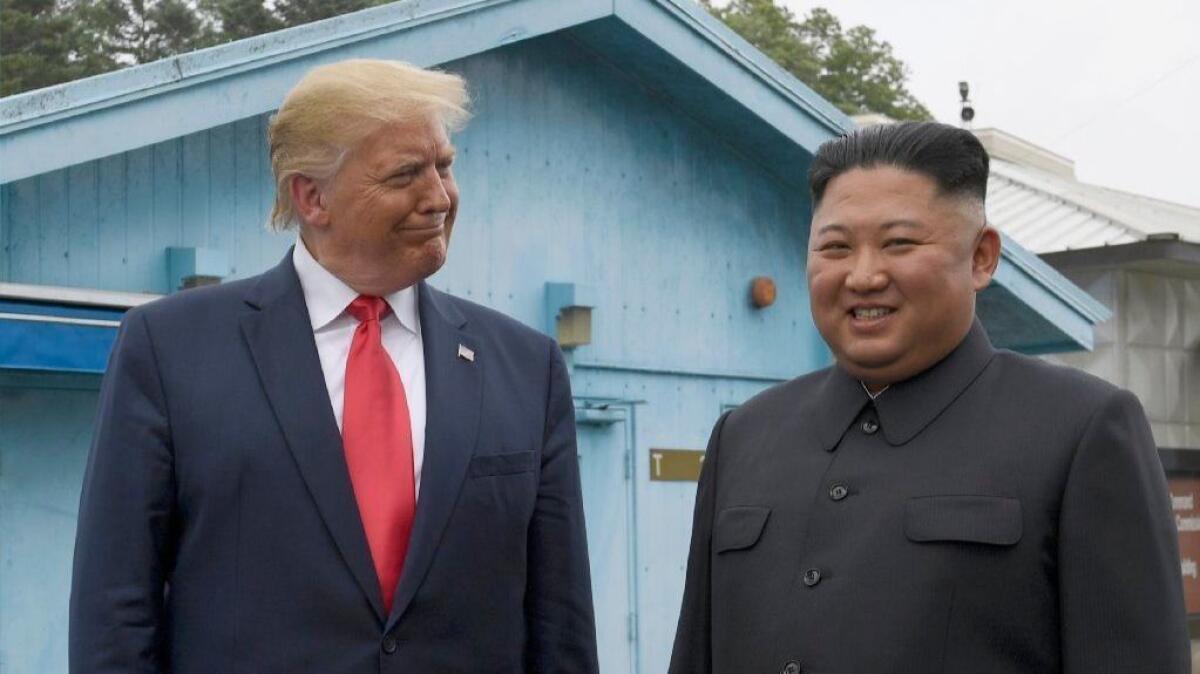Trump’s Potemkin diplomacy in North Korea

- Share via
Reporting from Washington — It’s undeniable: President Trump’s photo-op meeting with Kim Jong Un in the demilitarized zone that separates North and South Korea on Sunday made great television.
“This is a historic moment,” Trump said for the cameras, in case anyone missed the point.
But was it also great statecraft — or merely a clever stunt?
Without tangible progress soon, the apparently impromptu DMZ summit will turn out to have been Potemkin diplomacy — a shiny facade with nothing underneath.
The only agreement the two leaders announced was a decision to restart meetings of their lower-level diplomats. North Korea broke off those talks after Trump and Kim collided at their February summit in Hanoi.
Resuming the “working level” sessions is a step forward in procedural terms, but it’s no guarantee of substantive progress toward the U.S. goal — getting Kim to give up his still-growing arsenal of nuclear weapons and long-range ballistic missiles that can deliver them.
An earlier round of meetings went nowhere, mostly because Kim’s negotiators said they were not authorized to talk about nuclear weapons. They wanted to talk about their top priority instead: Kim’s demand for an end to international economic sanctions.
The tangled history of the negotiations since the first summit in Singapore in June 2018 is a lesson in the limits of personal diplomacy — even when the president and one of the world’s most ruthless dictators declare themselves best friends forever.
The rapprochement began after Trump appeared to threaten military action, famously threatening “fire and fury like the world has never seen” in August 2017.
Pyongyang responded by testing its most powerful long-range ballistic missile, one capable of reaching the continental United States, and staging its largest-ever nuclear test. South Korea and China were sufficiently concerned that they pressed Kim to ratchet back.
That winter, Kim sent signals that he might be willing to talk. Whether he suspended nuclear and intercontinental ballistic missile tests as a confidence-building measure, or simply had enough data to feel he had achieved a secure deterrent, is a matter of debate.
After their brief Singapore summit, Trump and Kim issued a vaguely-worded commitment to seek peace, prosperity and “the denuclearization of the Korean peninsula.”
But it quickly became clear that the two leaders had never settled on a common definition of denuclearization — hence the danger of personal diplomacy.
The U.S. side wants North Korea to give up its nuclear arsenal and production facilities. North Korea wants the removal of the U.S. nuclear umbrella over South Korea.
At Hanoi, the two leaders arrived with specific proposals — and each side pushed too far.
Trump asked for complete denuclearization — again loosely defined — in exchange for a vague promise of U.S. investments in North Korea’s economy. Kim proposed closing one of his several nuclear weapons complexes in exchange for lifting most international sanctions.
That brings us to where we are today. Here’s a scorecard:
Kim’s military is still producing nuclear material and improving its missiles, including those capable of hitting U.S. forces in Japan and South Korea. U.S. officials admit that there’s no sign Kim intends to give up his nuclear deterrent.
Three summits with the U.S. president have bolstered Kim’s stature and his legitimacy as a leader, both at home and around the world.
On the U.S. side, Kim’s decision to suspend nuclear tests and long-range missile tests is clearly a good thing. But the underlying problem, a rogue communist regime with nuclear weapons, persists.
Despite the hoopla, Trump’s best-friend diplomacy has produced no lasting outcomes.
That might change if both leaders find a way to be more flexible — as Trump has already hinted he will do.
At the DMZ summit, the president never publicly mentioned the mantra that had long been his administration’s official goal: the “complete, verifiable, irreversible denuclearization of North Korea.”
Instead, Trump is now dangling the prospect of partial sanctions relief if North Korea takes initial steps to limit its nuclear program — freezing its plutonium and uranium production, for example, or dismantling more facilities than the one site Kim offered in Hanoi.
“Sanctions remain, yes, but at some point during the negotiations, things can happen,” Trump said after meeting Kim. “At some point, look, I’m looking forward to taking them off.”
That could mean the beginning of a long, step-by-step process — one aiming for modest, interim agreements that would postpone full denuclearization until the future. Diplomats and outside experts have long said that’s the only way a substantive agreement with North Korea can be achieved.
That likely would touch off a rebellion among Republican hawks — including John Bolton, Trump’s national security advisor — who have long opposed a partial agreement as a chimera.
But it might just be feasible. And it would offer the prospect of another flashy summit meeting, complete with a signing ceremony — this time, perhaps, in the middle of an election year. Could any president resist an opportunity like that?
More to Read
Get the L.A. Times Politics newsletter
Deeply reported insights into legislation, politics and policy from Sacramento, Washington and beyond. In your inbox twice per week.
You may occasionally receive promotional content from the Los Angeles Times.









